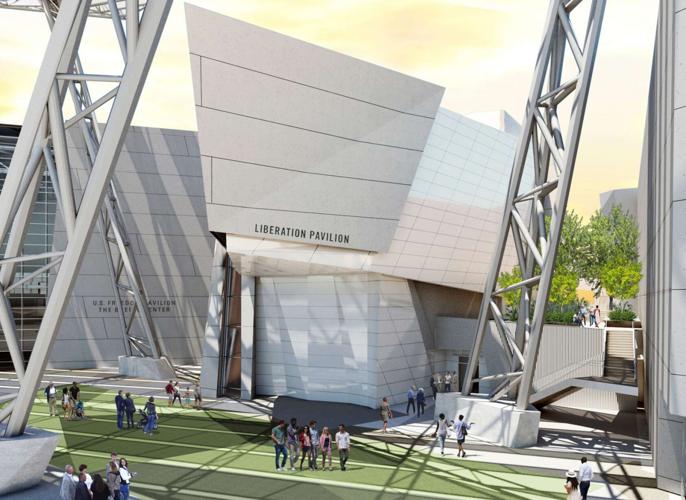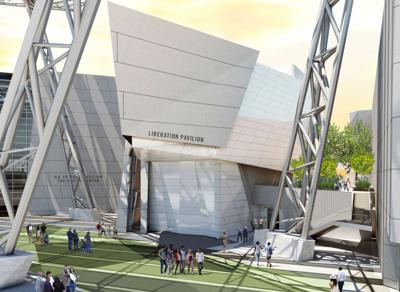The National World War II Museum on Tuesday announced the planned opening date of the $47 million Liberation Pavilion, its seventh and final permanent exhibition that will deal with the end of the war, the Holocaust and the post-war years.
The announcement was timed to coincide with the 79th anniversary of the Allied forces landings on the beaches of Nazi-occupied France, or D-Day.
June 6 is also the 23rd anniversary of the museum's opening, which was marked Tuesday with a ceremony in the museum's U.S. Freedom Pavilion, attended by several hundred members of the public. The band from the U.S. Marine Corps Support Facility on the West Bank played, and the Victory Belles trio sang "Happy Birthday" in the style of the Andrews Sisters.

Rendering of the Priddy Theater at the World War II Museum's Liberation Pavilion, which is expected to open Nov 3, 2023.
The Nov. 3 celebration — which will include the official opening of the Col. Battle Barksdale Parade Ground, an outdoor gathering space adjacent to the Liberation Pavilion — represents the culmination of the $400 million "Road to Victory" capital campaign that allowed the museum to grow from a single exhibit hall when it began over two decades ago.
The museum was the brainchild of University of New Orleans historian Stephen Ambrose and his friend and colleague Gordon "Nick" Mueller. It started out as a place to house artefacts that Ambrose, whose books include "Band of Brothers" and "Eisenhower: Soldier and President," had collected over the years.
Initially known as the D-Day Museum, it was designated the National WWII Museum by an Act of Congress in 2004. When completed in November, the museum will have seven pavilions covering different aspects of the global conflict. These include the Louisiana Memorial Pavilion, covering the home front; Campaigns of Courage, with over 19,000 square feet of space showing the jungles, beaches and mountains where battles were fought; and the Hall of Democracy, focusing on education.
The six-acre campus has become one New Orleans' major tourist attractions, with more than 780,000 visitors a year before the COVID-19 pandemic. Admissions and membership fees in 2019 totaled about $30 million of the museum's total $110 million in revenue. More than 80% of visitors in a typical year come from out of state.
The November opening will be "in time for the last surviving members of the WWII generation to experience what has been built in their honor," the museum said in a news release.

Col. Battle Barksdale Parade Ground, an outdoor gathering space adjacent to the Liberation Pavilion.
"The Liberation Pavilion will be a powerful addition to the museum experience, providing visitors with a deeper understanding of the cost of our victory and the war’s enduring impacts," said Stephen Watson, the museum's CEO.
The three-story pavilion was funded by an $18 million allocation by the state of Louisiana as well as private donations. A third-floor cinema at the building — the Freedom Theater — was funded by a $7.5 million donation from the Priddy Family Foundation, a charitable trust of airline executive Robert Priddy and his wife, Kikie.
The museum project has also included the $66.5 million Higgins Hotel, which opened in 2019.
"Liberation Pavilion will help us tell a more complete story of the American experience in the war and emphasize how its far-reaching impacts continue to affect our lives today,” said Michael Bell, executive director of the museum's Jenny Craig Institute for the Study of War and Democracy.
Immersive theater
The Pavilion’s first floor galleries, Finding Hope in a World Destroyed, will honor the sacrifices of the WWII generation and explore the immense cost of war with exhibits on the Holocaust, Anne Frank, faith in wartime and the Monuments Men and Women, the museum said.
It will also include a panoramic theater with personal testimonies from Holocaust survivors and the US forces who liberated. There will also be an interfaith chapel to provide a quiet space for contemplation.
The pavilion's second floor — the Goldring Family Foundation and Woldenberg Foundation Forces of Freedom at Home and Abroad (1945–Present) — will explore topics including the rebuilding effort, the war crimes tribunals and the war’s impact on foreign policy.
The third-floor cinema production, being developed by The Hettema Group, will highlight the pre-war years and how freedom and democracy were nearly extinguished.
"At a pivotal moment in the show, the theater audience platform itself will rotate," the museum promises.
The adjacent 24,000-square-foot Col. Battle Barksdale Parade Ground was funded by a donation from Donna and Jim Barksdale, a former museum trustee, who earmarked the funds for the space to honor his uncle, Col. Battle Barksdale, an Army officer in World War II.
Beyond our dreams
"Steve often spoke of his dream for the Museum to serve as a ‘love song to democracy,’ a dream that has come true over the past 20 years,” said Mueller, emeritus CEO of the museum.
"We have achieved something beyond what (he) and I could have imagined when we set out to create The National D-Day Museum," he added.




